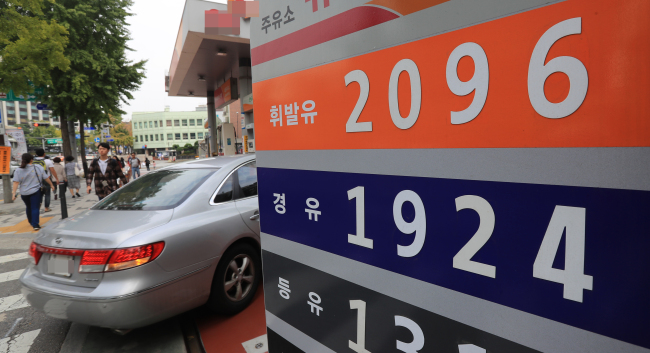Ministry to conduct mandatory nitrogen oxide test on diesel cars
By Kim Da-solPublished : Oct. 18, 2017 - 16:56
Starting from 2021, South Korea will require diesel vehicles to receive mandatory nitrogen oxide examinations as part of its plan to reduce emissions and improve air quality here, the Environment Ministry said Wednesday.

According to the new rule, small and midsized diesel vehicles that are manufactured from January 2018 onward and registered in metropolitan areas including Seoul, Incheon and 15 cities in Gyeonggi Province will be required to go through a test to see if they meet the regulatory standard for nitrogen oxide emissions, in addition to the country’s existing emissions tests.
South Korea will be the world’s first country to enforce mandatory nitrogen oxide tests on vehicles.
Data from the London-based Emissions Analytics last year showed that 97 percent of all modern diesel cars emit more toxic nitrogen oxide pollution on the road than the official limit, with a quarter producing at least six times more than the limit.
Diesel engine cars are blamed as a major source of locally originated fine dust in South Korea.
Owners of vehicles exceeding the permissible level of nitrogen oxide emissions must receive re-examination after checking nitrogen oxide reduction devices installed in the vehicles.
The ministry expects at least 2,870 tons of nitrogen oxide emissions will be reduced over the next decade, leading to a cut of 196 tons in secondarily produced PM 2.5.
The move follows the government’s 7.2 trillion won ($6.3 billion) project to reduce fine dust by 30 percent by 2022 by closing down aging coal-powered plants and replacing old diesel cars.
The ministry said it would gradually expand the nitrogen oxide examination system to other regions after the introduction in metropolitan areas.
In August, the Seoul Metropolitan Government unveiled a plan to inject a total of 80 billion won by the year’s end to reduce the number of old diesel cars in order to fight air pollution in the metropolitan area.
The city government data revealed that household heating accounted for 39 percent of locally produced fine dust, while vehicles produced 37 percent, largely caused by the wearing of tires on roads. Concrete manufacturing and construction work contributed to 22 percent.
By Kim Da-sol (ddd@heraldcorp.com)


![[AtoZ into Korean mind] Humor in Korea: Navigating the line between what's funny and not](http://res.heraldm.com/phpwas/restmb_idxmake.php?idx=644&simg=/content/image/2024/04/22/20240422050642_0.jpg&u=)


![[Exclusive] Korean military set to ban iPhones over 'security' concerns](http://res.heraldm.com/phpwas/restmb_idxmake.php?idx=644&simg=/content/image/2024/04/23/20240423050599_0.jpg&u=20240423183955)
![[Herald Interview] Why Toss invited hackers to penetrate its system](http://res.heraldm.com/phpwas/restmb_idxmake.php?idx=644&simg=/content/image/2024/04/22/20240422050569_0.jpg&u=20240422150649)
![[Graphic News] 77% of young Koreans still financially dependent](http://res.heraldm.com/phpwas/restmb_idxmake.php?idx=644&simg=/content/image/2024/04/22/20240422050762_0.gif&u=)







![[Exclusive] Korean military to ban iPhones over security issues](http://res.heraldm.com/phpwas/restmb_idxmake.php?idx=652&simg=/content/image/2024/04/23/20240423050599_0.jpg&u=20240423183955)



![[Today’s K-pop] Ateez confirms US tour details](http://res.heraldm.com/phpwas/restmb_idxmake.php?idx=642&simg=/content/image/2024/04/23/20240423050700_0.jpg&u=)